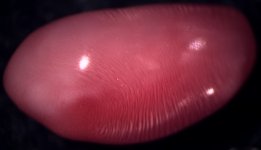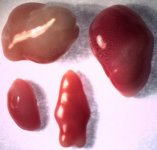You are using an out of date browser. It may not display this or other websites correctly.
You should upgrade or use an alternative browser.
You should upgrade or use an alternative browser.
Culturing Conch Pearls
- Thread starter jshepherd
- Start date
kojimapearl
Well-known member
- Joined
- Feb 13, 2007
- Messages
- 445
This is so very exciting.. a truly historic turn of events in the world of pearls. It will be interesting to see both how they are marketed when the production gets to that level, and also how it will effect such a high end market of people who have seemingly bought and sold on the absolute premise that conch pearls were both pink and NATURAL! Congratulations for your efforts, and all your hard work.
pearlescence
purveyor of pearls UK/EU
- Joined
- Aug 18, 2007
- Messages
- 4,120
Okay, pink always floats my boat!
Congratulations to the university on great research. I wonder now at the commercial implications and repercussions,
Congratulations to the university on great research. I wonder now at the commercial implications and repercussions,
SteveM
Well-known member
- Joined
- Jan 29, 2007
- Messages
- 2,081
Great pictures and very impressive pearls. A whole new world, can't wait to hear what pearling techniques might influence color and flame in addition to shape.
Agree with Sarah that it will be very interesting to see how this eventually affects the natural market, the conch pearl trade being particularly elitist and cartel-like.
Agree with Sarah that it will be very interesting to see how this eventually affects the natural market, the conch pearl trade being particularly elitist and cartel-like.
hacostas
New Member
- Joined
- Sep 5, 2006
- Messages
- 36
Here is some info. First photo: The white pearl is 0.56 g; dark pink 0.45 g, 8.9 mm. orange-pink 0.48 g; light pink 0.513 mm, 8 mm. Second photo 0.314 g (1.57 ct) 6.1 mm. Third photo 0.234 g (1.17 ct) 6.5 mm. Last photo 0.051 g (0.255 ct).
Thanks all for your encouraging words.
you are right. all this work was conducted indoors in recirculating aquaculture tanks. the conch are feed an artificial diet enriched with dry algae (similar to shrimp or fish feeds)
Thanks all for your encouraging words.
I am assuming saltwater is pumped into aquaculture tanks just like at some aquariums in California. What kind of food or nutrients are given to them?
you are right. all this work was conducted indoors in recirculating aquaculture tanks. the conch are feed an artificial diet enriched with dry algae (similar to shrimp or fish feeds)
SteveM
Well-known member
- Joined
- Jan 29, 2007
- Messages
- 2,081
Microscopic, but exceedingly beautiful. Would it be possible to take another shot on a coin to show what features may be visible to the unassisted eye?Last photo 0.051 g (0.255 ct).
Pearl Dreams
Pearl Enthusiast
- Joined
- Sep 24, 2007
- Messages
- 10,005
Wonderful news!
Miriam Reed
New Member
- Joined
- Mar 30, 2008
- Messages
- 247
How exciting! This is really marvelous news. Congratulations to those involved! The photos are impressive.
BeadersSecret
Professional Rethreader
- Joined
- Mar 23, 2006
- Messages
- 508
I have looked at this thread a few times-just mind blowing.
Congratulations to the big and wee folk involved in this project.
Congratulations to the big and wee folk involved in this project.
Mervione
New Member
- Joined
- Feb 1, 2008
- Messages
- 679
I think this is wonderful!
I love to read about the science of pearls, it?s very interesting. Maybe one day I could become a pearl scientist myself! If so I?d do my best to figure out how to culture abalone pearls (my favorites I think!) and how to produce huge, perfect freshwater pearls. It would be cool if more research would be done about how pearls get their colours and luster as well.
It would be cool if more research would be done about how pearls get their colours and luster as well.
I love to read about the science of pearls, it?s very interesting. Maybe one day I could become a pearl scientist myself! If so I?d do my best to figure out how to culture abalone pearls (my favorites I think!) and how to produce huge, perfect freshwater pearls.
Absolutely Astounding! I've been in love with conch pearls for a long time and always wondered when culturing techniques would improve to the point of producing these gorgeous gems...
It's kind of funny that the easiest way to nucleate the snails is to drug them... Nyquil for everyone! Lol...
It's kind of funny that the easiest way to nucleate the snails is to drug them... Nyquil for everyone! Lol...
SteveM
Well-known member
- Joined
- Jan 29, 2007
- Messages
- 2,081
Reading from Hubert Bari's beautiful book on conch pearls and conch pearl jewelry The Pink Pearl (published in 2007, the subject experiment of this thread apparently already underway), on page 65 the author reports prior pearl culturing activity, and the technical impossibility of implanting a bead within the spiral of a conch shell. The experiment was purposefully abandoned in favor of retaining Conchs as unique products of Mother Nature. Furthermore:
In Bari's forthcoming book on Abalone pearls we might hope for a similar pronouncement and the incentive it would provide to ongoing experiments in that field.
I suppose this could be taken as the unofficial 'cartel' position. I trust there is a secure lock on that Florida laboratory!Gem dealers, jewellers and collectors share this preference: when they are asked whether they want cultured conch pearls, the answer is a unanimous negative: 'The conch is the only natural pearl with no cultured pearl counterpart. Let's keep it that way.'
In Bari's forthcoming book on Abalone pearls we might hope for a similar pronouncement and the incentive it would provide to ongoing experiments in that field.
hacostas
New Member
- Joined
- Sep 5, 2006
- Messages
- 36
Microscopic, but exceedingly beautiful. Would it be possible to take another shot on a coin to show what features may be visible to the unassisted eye?
Steve, I have no photo of that small pearl (or of any pearl for that matter, next to a coin) and I'm now geographically too far from the conch pearls to take new photos. Here's a photo of 4 pearls. The top right pearl is the same I posted before, the pearl on the lower left is that small pearl you wanted a photo from. The photo is not that good. You can see flame with your naked eye in both pearls.
I also read that quote from 'the pink pearl' book. I think the farm (in the Turks and Caicos) by that time had been experimenting for a while but they didn't have good results. I think that is why they abandoned the experiment and not because they wanted to keep the conch pearl as an exclusivity of mother nature. If they wanted this, they wouldn't have tried in the first place.
As for the abalone, I look forward to reading in this forthcoming book what they say about such 'impossibility'
Attachments
SteveM
Well-known member
- Joined
- Jan 29, 2007
- Messages
- 2,081
Or perhaps the 'cartel' provided some convincing of another kind?I think that is why they abandoned the experiment.
Thanks for another impressive photo.
Hanaleimom
Member
- Joined
- Dec 27, 2007
- Messages
- 1,473
Extremely beautiful pink!!! It reminds me of surf clam meat (not the shell) which has similar color. Thank you for the photos.
Last edited:
Valeria101
New Member
- Joined
- Sep 7, 2006
- Messages
- 2,067
Around the time when I joined the forum [years! Ha! when did it pass?...] I had found a report of successful conch pearl culture at some aquaculture research facility in Indonesia. The exercise had no commercial following reported. Any idea if things went any further? [I am trying to find out the reference - it is 'hiding' right now]
Similar threads
- Replies
- 81
- Views
- 3K
- Replies
- 0
- Views
- 16K
- Replies
- 22
- Views
- 7K


